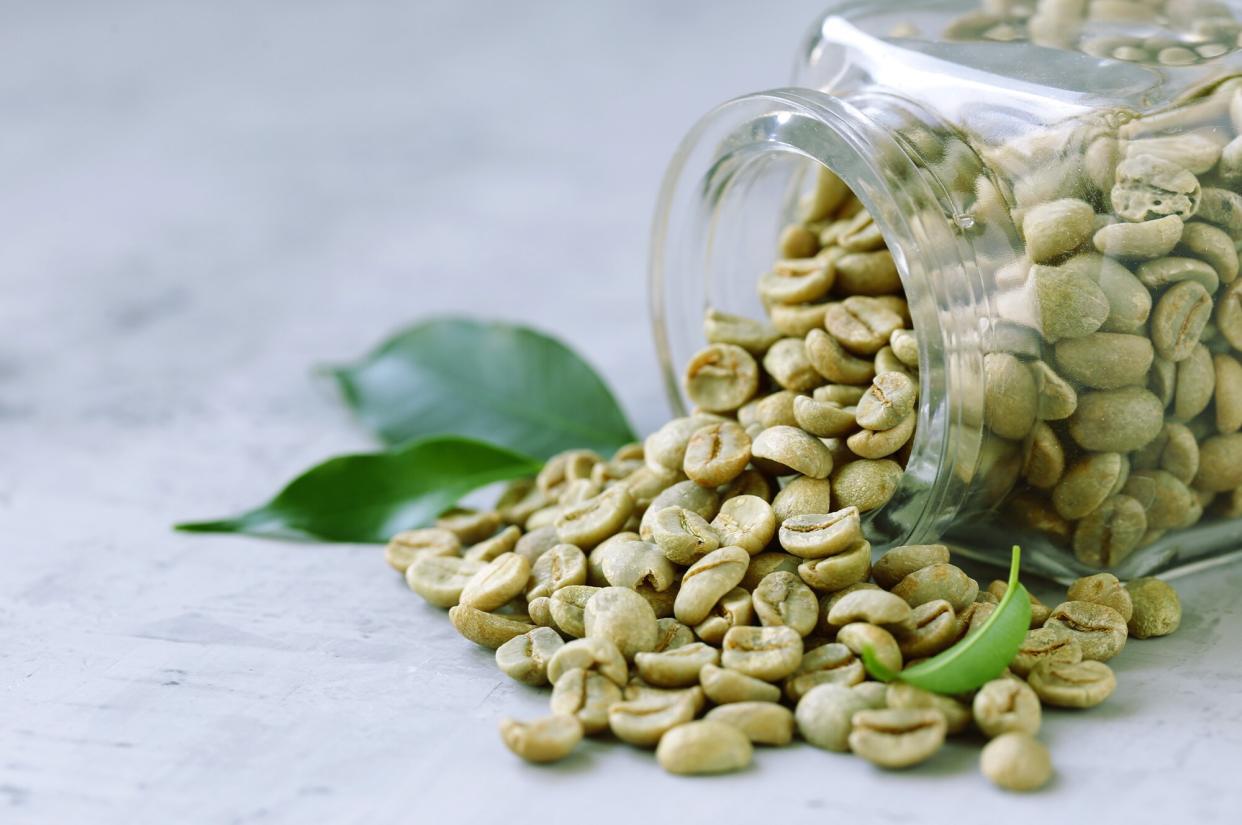What's All the Buzz About Green Coffee?

TABLE OF CONTENTS
On This Page
How Coffee Is Processed
Caffeine Content
Why Choose Unroasted Coffee?
How to Make Green Coffee
Green coffee is a buzzword often seen on social media and coffee ads, but what is it exactly? For the coffee industry, green coffee is the origin of all brews, but at home, it's rare consumers stumble on this unroasted type of coffee.
How Coffee Is Processed
"Green coffee is the prepared seed of the fruit from the coffee tree," explains Chris Miller, director of coffee at La Colombe Coffee Roasters. "The cherries of the tree are picked, often by hand, processed at their country of origin, and then exported to roasters throughout the world." The cherries, which hold the beans inside, are sometimes dried as cascara, which can be used to steep teas, or just composted.
Related: What Are the Health Benefits Associated with Drinking Tea?
The green coffee processing involves the harvested coffee being sorted, de-pulped, washed, dried, hulled, graded, and then exported to roasters across the world. "Once this coffee is prepared, it generally has a greenish hue to it, which leads to the seeds being called green coffee," Miller says. The "green" term has nothing to do with environmentalism, it is just the literal color of the coffee bean itself.
When coffee roasters receive these processed coffee cherries, or coffee beans, they're roasted until they reach a dark brown hue. Coffee comes from two different species of trees, Arabica and Robusta, each with their own distinct characteristics in flavor, and green coffee comes from both. Green coffee is more expensive to ship than roasted coffee, which is dryer and contains less moisture—so while high-end roasteries will only source green coffee, other coffee brands will want to save on shipping weight by purchasing pre-roasted coffee from wholesalers. Roasted coffee beans can also be imported directly.
"Green coffee, in and of itself, isn't edible," Miller says. "Once the coffee is roasted and the cellular walls break down is when the green coffee becomes brittle and is able to be ground for brewing." The roasting process can bring out notes of chocolate, fruits, citrus, nuts, sugars, spices, grains, and many more flavors. Green coffee won't have that typical coffee flavor, or scent, because it's unroasted. Those who get their hands on green coffee can also try their hand at roasting the raw beans, either in a pan on the stovetop or in the oven. It's a fun process to see how coffee goes from green coffee to the coffee we know and love.
Caffeine Content
Roasting dehydrates and shrinks coffee beans, meaning beans will have a higher content of caffeine for their volume—grinding 2 tablespoons of roasted beans to brew versus 2 tablespoons of green coffee will result in a more caffeinated beverage for the roasted beans. Medium roast coffee has been found to have the highest caffeine content (203.63 milligrams per liter), while green coffee has about 166.72 milligrams per liter. However, some people may enjoy drinking green coffee made with a higher ratio of green beans to water, which creates a more caffeinated drink, thanks to the amount of beans used. Ground or crushed green coffee beans can also be used to make a strong cold brew, to be enjoyed on its own or stirred into traditional cold brew coffee.
Why Choose Unroasted Coffee?
Many people are partial to raw, unroasted green coffee beans, which taste grassy and more like a mild green or herbal tea than like roasted coffee. And much like other raw produce, green coffee contains nutrients that are lost in the cooking process. Green coffee is renowned for having the highest content of chlorogenic acid, at 543.23 milligrams per liter. Chlorogenic acid is a potent antioxident that can also be found in raw apples, artichokes, carrots, grapes (including some wines!), pears, plums, and several other types of produce.
How to Make Green Coffee at Home
Green coffee can be purchased directly from specialty roasteries and online. The beans typically stay fresh for up to a year, stored in a closed container in a cool, dark place. Note that some green coffees may have been harvested months before they ship, which can affect the freshness.
To brew a cup of green coffee, start by grinding the beans to your desired coarseness. They are notoriously more difficult to grind, so a hand grinder or strong electric burr grinder may be necessary. Anything less than professional grade may break—if you don't think your grinder could grind an uncooked, unsoaked black bean, don't use it. A mortar and pestle can also get the job done in crushing green coffee. Some people prefer to soak their green coffee beans in water overnight to soften them up, similar to how dry beans are soaked before cooking.
Green coffee beans also take longer to extract flavor from, so you'll want to brew them using a French press. Add hot water, steep for about 10 minutes and plunge down the strainer to separate. The liquid will be light brown, like tea. Taste and adjust your bean, water, time ratio as desired.

